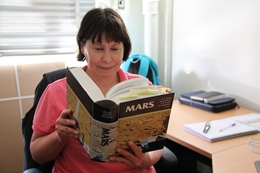10 August 2016
 It’s been almost a year since NASA’s sensational announcement that liquid briny water flows on the surface of Mars, with water ice present at polar and sub-polar latitudes.
It’s been almost a year since NASA’s sensational announcement that liquid briny water flows on the surface of Mars, with water ice present at polar and sub-polar latitudes.
To highlight just how scientists are able to explore the Red Planet to find buried ice and ancient frozen lakes, and the implications of such findings, Dr Graziella Caprarelli will be presenting a seminar as part of National Science Week, this Sunday (August 14) organised by Mars Society Australia.
The presentation: “Looking for ice in unlikely places”, will see Dr Caprarelli, Associate Professor in Space Science at the University of South Australia explain the physical conditions for ice and water stability on the surface of Mars.
Dr Caprarelli will illustrate the astronomical and geological processes responsible for the existence of ice on the surface of the planet during different periods of its geological history, and present new insights into the likelihood and distribution of cold and wet microenvironments of astrobiological potential.
“The present day Martian surface is cold and hyper-arid, but water ice is present on the planet and various models show that an ice ground table is globally stable at variable depths,” Dr Caprarelli says.
“Geological, geomorphological and astronomical evidence however indicate that ice was, in the past, likely to be much more ubiquitous on Mars.
“Any new information or understanding of the type, range and locations of habitable environments on Mars impacts scientists’ decisions on where to land the next Martian rovers to explore for traces of life”.
The scientific profile of the research carried out in this field by Dr Caprarelli, her UniSA colleague, Dr Eriita Jones, and international collaborators, is testified by their latest paper making the cover of the latest issue of the Journal of Geophysical Research: Planets.
The paper, by Jones, Caprarelli and Osinski (of the University of Western Ontario, Canada) is entitled: “Insights into complex layered ejecta emplacement and subsurface stratigraphy in Chryse Planitia, Mars, through an analysis of THEMIS brightness temperature data” and was published earlier this year in volume 121 of the journal, at pages 986-1015.
“We analysed the grain size trends in materials excavated by impact craters on Mars, using thermal infrared data,” Dr Jones says.
“We found that the grain sizes can be used to constrain the abundance of subsurface water that was present when the crater formed. This allows us to use ancient impact features to learn about the presence of ice in the Martian subsurface millions of years ago.”
Registrations for Dr Caprarelli’s presentation, which starts at 6pm on Sunday, at Nova Systems, 27-31 London Road, Mile End South, can be made here.
Media contact: Will Venn mobile: +61 0401 366054 email: will.venn@unisa.edu.au



